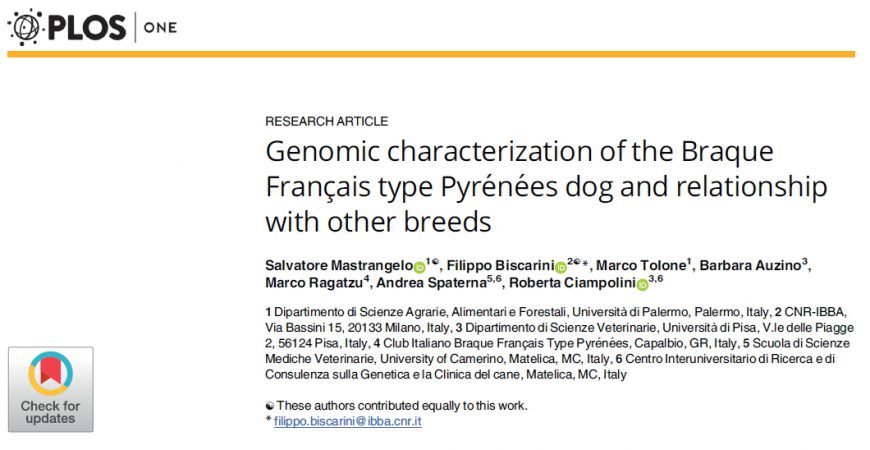
Articolo pubblicato sulla rivista PLOSONE
Autori: Salvatore Mastrangelo, Filippo Biscarini, Marco Tolone, Barbara Auzino, Marco Ragatzu, Andrea Spaterna, Roberta Ciampolini.
ABSTRACT
The evaluation of genetic variability is a useful research tool for the correct management of selection and conservation strategies in dog breeds. In addition to pedigree genealogies, genomic data allow a deeper knowledge of the variability and genetic structure of populations. To date, many dog breeds, such as small regional breeds, still remain uncharacterized. Braque Français type Pyrénées (BRA) is a dog breed originating from a very old type of gun-dog used for pointing the location of game birds to hunters. Despite the ancient background, the knowledge about levels of genetic diversity, degree of inbreeding and population structure is scarce. This may raise concerns on the possibility that few inbred bloodlines may dominate the breed, and on its future health. The aim of this work was therefore to provide a high-resolution representation of the genome-wide diversity and population structure of BRA dogs, using the 170K genome-wide SNP array. Genome-wide polymorphisms in BRA were compared with those of other worldwide dog breeds. Between-dog relationships estimated from genomic data were very similar to pedigree relationships (Pearson correlation rg,a = 0.92). Results showed that BRA generally presents moderate levels of genetic diversity when compared with the major canine breeds. The estimated effective population size (recent Ne = 51) shows a similar declining pattern over generations as all other dog breeds, pointing at a common demographic history of modern canine breeds, clearly different from the demography of feral wolves. Multidimensional scaling (MDS), Bayesian clustering and Neighbor Joining tree were used to visualize and explore the genetic relationships among breeds, and revealed that BRA was highly differentiated and presented only low levels of admixture with other breeds. Brittany Spaniel, English Setter, Gordon Setter and Weimaraner dogs are the closest breeds to BRA. The exact reason for BRA being so divergent from other dog breeds, based on these results, is not yet clear. Further studies including additional <braccoid> breeds will be needed to refine the results presented here and to investigate the origin of the BRA breed. Nonetheless, the genome-wide characterization reported here provides a comprehensive insight into the genome diversity and population structure of the BraqueFrançais, type Pyrénées breed.








